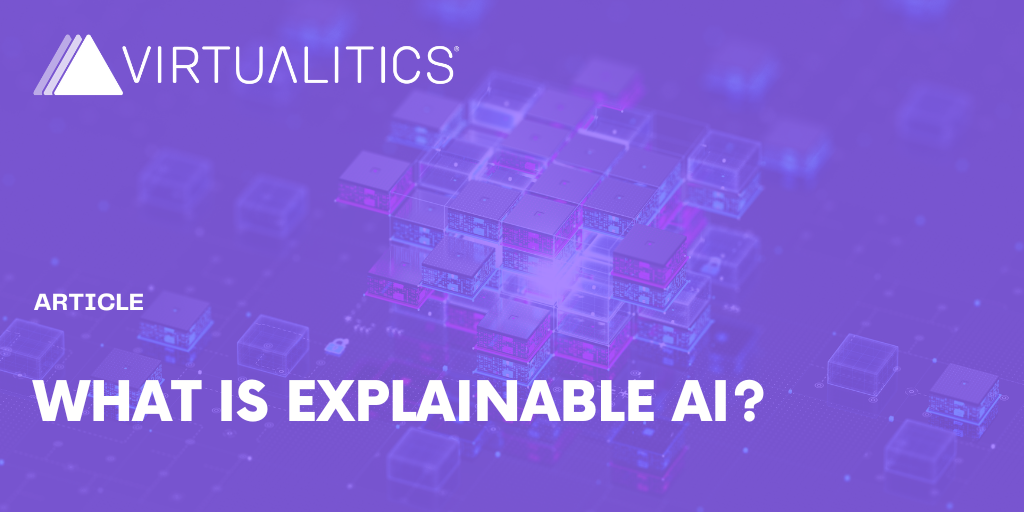What is Explainable AI and How Does it Impact Business Analysis

Written by Ciro Donalek
May 29, 2024 7:20:22 PM

Explainable artificial intelligence (XAI) is a framework that helps humans understand and trust the insights and recommendations created by their AI models. It’s a key component in both decision intelligence best practices and ethical AI principles.
Every day, organizations generate a vast amount of data points, and analyzing and interpreting these extensive datasets is not something that business analysts can easily accomplish. Innovations in AI are a boon to data analysis, speeding up analytical and interpretation practices so that companies can get to more accurate answers faster. Despite this, 61% of people are still wary about trusting AI systems, reports a 2023 KPMG study on the global study on the shifting public perceptions of AI.
XAI is crucial not only to increase trust in AI but also its utilization, which helps organizations develop the competitive advantage needed to thrive in today’s data-first world.
Why is Explainable AI Important?
As AI has become more advanced, it has developed a “black box” nature, making it difficult to interpret how it arrives at certain results or recommendations. XAI bridges the gap between the complexity of AI models and the human need for clear, understandable, and trustworthy outcomes.
One way XAI creates trust is by delivering key insights and next steps in natural language and augmenting explanations with visualizations to help users better understand how the system came to its conclusion. For example, supply chain managers can use XAI technology to determine why the system is suggesting certain suppliers or how it determines the best way to optimize inventory levels.
By making explanations clear and transparent, users are more likely to adopt AI technologies in their data analysis and make smarter decisions.
How Does Explainable AI Work?
To be effective, XAI has to strike the right balance between interpretability and accuracy. It is essential that developers don’t compromise accuracy while focusing on context-aware explanations. In a nutshell, these are the two main components of an XAI framework:
- The AI identifies insights and recommendations hidden in the data
- The AI “explains” to the user why these insights and recommendations are significant and justifiable
Additionally, XAI systems generate explanations suitable for different audiences that don’t require a data expert to interpret them. By leveraging Natural Language Processing (NLP) and Generative AI, XAI systems are able to present results in the form of a narrative, featuring simple language and relevant charts that are generated automatically.
What is the Difference Between AI and XAI?
While AI and XAI are related concepts, their main difference is in their purpose. With AI, its core goal is to make intelligent decisions and perform tasks using machine learning algorithms; however, in doing so, it’s not required to be clear about how it arrived at a decision or prediction.
XAI, on the other hand, uses specialized models and algorithms to provide explanations and reasoning for how it came to a certain conclusion. The goal of XAI is transparency and accountability. This transparency is what differentiates XAI from more traditional, often opaque AI systems that do not provide insights into their decision-making processes.
6 Benefits of Explainable AI for Business Analysis
Increasing the trust and adoption of AI technologies is one of the biggest advantages of using XAI systems, but it’s not the only way XAI is useful for business analysis. Here are six more benefits to leveraging XAI:
1. Pinpoints the “why” behind insights
While it can be tempting to just take an actionable insight and run with it, there is a lot more to be gained when you have a deeper understanding of why that result might create value for your business. The transparency of XAI gives you the opportunity to interrogate results rather than taking them at face value so you can be assured that you’re taking the best strategic route.
2. Makes recommendations easier to follow
When coupled with NLP and Large Language Models (LLMs), XAI takes on a conversational tone that feels more like an advisor is instructing you rather than a machine. By explaining the next steps in the form of a narrative, analysts and non-technical users have a simpler time navigating analyses and reports.
3. Increases productivity
Explainability shortens the path to understanding, enabling a faster time to value in business analytics. For example, predicting when manufacturing equipment will fail can prevent numerous problems, but understanding how those predictions are made is essential. Analytics platforms equipped with XAI can clarify why manufacturing equipment fails by providing transparent, traceable explanations of the data, reasoning behind each prediction, and even the reliability of the data used.
4. Improves AI accessibility
XAI is crucial to faster and smarter decision-making since it enables even non-technical audiences to engage with and trust AI technologies. By breaking down complex models into understandable terms, the black box around AI is lifted and anyone can feel empowered to use AI accurately and in alignment with business goals and values.
5. Bridge communication gaps
Both data scientists and analysts can leverage XAI’s explanations to distill complex concepts into actionable stories and visualizations that help business stakeholders more easily grasp the significance or value of any data-driven recommendations.
6. Mitigate regulatory and compliance risks
XAI gives legal and compliance teams the explanations they need to confirm whether a new strategy or solution follows laws and regulations, as well as company values and policies. As global AI rules and regulations are put into place—such as the EU’s AI Act—explainability will go a long way in helping organizations stay compliant.
Challenges in Adopting Explainable AI
There are ongoing challenges that keep AI technologies from becoming more broadly adopted within data analysis including:
Lack of resources: With data science talent becoming increasingly difficult to find and hire for, many AI projects and implementations are put on hold. There is momentum for data analysts to become upskilled in advanced AI and analytics techniques, which will help get more AI and XAI systems up and running at organizations.
Lack of trust: As KPMG’s study showed, lack of trust continues to limit the use of AI in day-to-day business workflow. XAI is key to building more confidence in the use of these technologies.
Lack of usability: Traditional BI and analytics platforms are not designed for non-technical users to explore and visualize data. As XAI is embedded in more analytics platforms, these tools will also become more democratic and straightforward to use.
Building a Common Language for Decision-Making
AI enhances data analysis by fostering understanding and evolution in data exploration, aiming not to replace humans in the process, but to assist in revealing the narratives hidden within the data. Explaining data in an approachable manner is critical for improving decision-making across your company. Integrating XAI and other AI technologies as partners in this process is a smart and effective strategy to develop a common data language that everyone can understand and benefit from.
